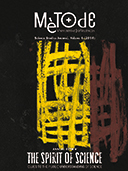The conquest of readers. Evolutionary challenges of science communication in an extreme environment
DOI:
https://doi.org/10.7203/metode.80.3076Keywords:
communication, science communication, media, science journalism Abstract
Abstract
The huge responsibility of the media lies in the fact that citizens have the right to science information, to help them take better decisions, nurture a critical spirit, and form their own opinions; to update their knowledge and make them part of the culture of their time. Nowadays, the written press faces a rapidly changing and competitive environment, threatening the survival of traditional science communication. Professionally speaking, this is the moment for science communication to evolve, but also to keep the essential element: the root of good journalism, to stand out for quality and boldness, in order to be readers’ choice. There is still room for development, production, communication craftsmanship and profession.
 Downloads
Downloads
 References
References
Calvo Hernando, M., 1997. Manual de periodismo científico. Editorial Bosh. Hospitalet de Llobregat.
Calvo Hernando, M., 2005. Periodismo científico y divulgación de la ciencia. ACTA-CEDRO. Madrid.
Campillo, I., 2012. «Sirimiri de ciencia». El Correo, 19 November. Available at: <http://ciencia.elcorreo.com/firmas/2012-11-19/sirimiri-ciencia-20121119.html>.
Casero-Ripollés, A., 2012. «Beyond Newspapers: News Consumption among Young People in the People in the Digital Era». Comunicar, 39: 151-158. DOI: <10.3916/C39-2012-03-05>.
De Semir, V., 2007. La ciencia en los medios de comunicación. Prodisa. Barcelona.
De Semir, V., 2010. Science Communication & Science Journalism. Media for Science Forum. Madrid. Available at: <http://www.mediaforscience.com/Resources/documentos/booklet_en.pdf>.
Elías, C., 2003. La ciencia a través del periodismo. Nivola. Tres Cantos.
Elías, C., 2008. Fundamentos de periodismo científico y divulgación mediática. Alianza Editorial. Madrid.
FECYT, 2012. VI Encuesta de Percepción Social de la Ciencia. Fundación Española para la Ciencia y la Tecnología. Madrid. Available at: <http://www.fecyt.es/fecyt/docs/tmp/363174605.pdf>.
Fundación BBVA, 2012. Estudio Internacional de Cultura Científica. Departamento de Estudios Sociales y Opinión Pública de la Fundación BBVA. Madrid. Available at: <http://www.fbbva.es>.
Perla Mateo, M. P., 2011. «Iñaki Gabilondo: el tic-tac del corazón frente a la máquina de escupir noticias». De cero a ciencia, 7 June. Available at: <http://blogs.heraldo.es/ciencia/?p=2265>.
Perla Mateo, M. P., 2013a. «Antonio Calvo Roy: “La ciencia es aún la hermana pobre de los medios de comunicación”». Heraldo de Aragón, Tercer Milenio, 19 March.
Perla Mateo, M. P., 2013b. «Patricia Fernández de Lis: “El periodista científico es rara avis en las redacciones”». Heraldo de Aragón, Tercer Milenio, 18 June.
Sanz, E., 2013. «La ciencia que cuenta es la que se cuenta». Agencia Sinc, 4 February. Available at: <http://www.agenciasinc.es/Opinion/La-ciencia-que-cuenta-es-la-que-se-cuenta>.
Published
How to Cite
-
Abstract693
-
PDF118
-
PDF (Català)117
-
PDF (Español)107
Issue
Section
License
![]()
All the documents in the OJS platform are open access and property of their respective authors.
Authors publishing in the journal agree to the following terms:
- Authors keep the rights and guarantee Metode Science Studies Journal the right to be the first publication of the document, licensed under a Creative Commons Attribution-NonCommercial-NoDerivatives 4.0 International License that allows others to share the work with an acknowledgement of authorship and publication in the journal.
- Authors are allowed and encouraged to spread their work through electronic means using personal or institutional websites (institutional open archives, personal websites or professional and academic networks profiles) once the text has been published.





